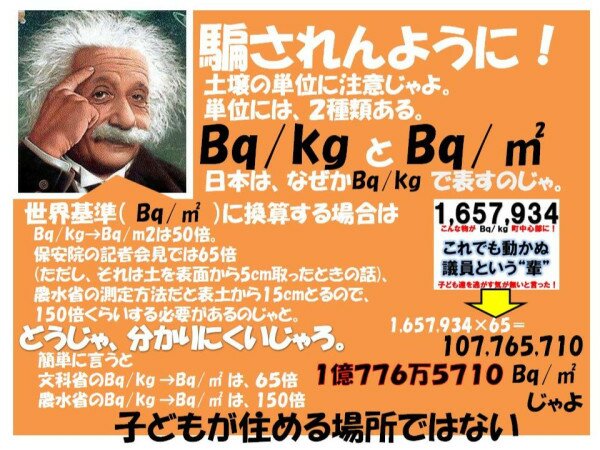Freelance journalist Rei Shiva [Shiba] writing for Nikkan Spa, a daily tabloid in Japan (part; 5/15/2012):
福島県南相馬市内で発見された超強力な放射能を持つ謎の“黒い粉”が話題になったのは今年2月のこと。
It was this February when the super-radioactive and mysterious "black dust" found in Minami Soma City in Fukushima Prefecture was in the news.
1kgあたり108万ベクレル」というケタ違いの線量は衝撃的なものの、「南相馬での特殊な事例」として受け止められていた。ところが、その「黒い粉」は東京都内の至るところに存在しているという。
Although 1.08 million Bq/kg was shocking, it was considered to be specific only to Minami Soma. However, I've been told that "black dust" exists everywhere in Tokyo.
「放射線検知器を近づけてみると、明らかに反応があるので、汚染度が高いのかなとは思っていたのですが、まさかここまでとは……」「黒い粉」を都内で発見した、市民団体「NO!放射能 江東こども守る会」の石川あや子代表は驚きを隠せない。「江戸川区のJR平井駅周辺で『黒い粉』らしきものを見つけ、採取したサンプルを神戸大学の山内知也教授に検査してもらったところ、最大で1kgあたり24万3000Bqという数値が出たんです」。
"When I brought the radiation detector closer, it visibly responded. So I knew it might be highly contaminated, but didn't know it was this contaminated...", says Ayako Ishikawa incredulously. Ishikawa is the head of the citizens' group "No! to Radiation, Protect Children in Koto". [Koto-ku is one of the eastern Special Wards of Tokyo]. She says, "We found something that looked like "black dust" near the Hirai JR station in Edogawa-ku. We collected the sample and and asked Professor Tomoya Yamauchi of Kobe University to measure the radiation. The result was that it had the maximum 243,000 Bq/kg [of radioactive cesium]."
これは原子炉等規制法で定められた「安全基準(クリアランスレベル)」の約2430倍という、途方もない数値だ。
It is 2,430 times the clearance level [100 Bq/kg] specified by the Nuclear Reactor Regulation Law.
「注意して見ると、『黒い粉』は都内の至るところにあります」と石川さんは言う。そんなにあちこちに高汚染の物質が転がっているのだろうか? という疑問を抱えつつ、「黒い粉」の調査に本誌記者も同行した。
"If you look carefully, "black dusts" are everywhere in Tokyo", says Ishikawa. Such highly contaminated materials are everywhere? I decided to accompany her to look for "black dusts".
まずは、JR平井駅から徒歩10分ほど。公営団地そばの運動場で「黒い粉」を発見した。フェンス近くで何か所にもわたって吹き溜まっていた「黒い粉」は、一見すると黒い土のように見える。近づいてよく見てみると、乾燥して干からびたコケやカビのようなものであるとわかる。
First, [to a location] about 10-minute walk from the JR Hirai Station. We found the "black dust" on the playground near the public housing. There were several drifts near the fence, and they looked like just "black soil". When I took a closer look, they were revealed to be something like a dried moss or mold.
「この前来たときと微妙に場所が変わっていますね。風雨で移動したのかもしれません」と石川さん。ガイガーカウンターよりも信頼性の高い、国産のシンチレーション式放射線検知器を「黒い粉」に近づけてみた。すると数値が急上昇し、毎時2μSvを超えた。東京都の平均的な空間線量(地上1m)の約20倍だ。山内教授は「一般的に携帯式の放射線検知器は周囲の放射線量の平均値を表示します。つまり、少量の物質に検知器を向けて数値が急上昇するならば、その物質が極めて強い放射線を出している可能性があります」という。
Ishikawa said, "They are at slightly different locations. Rain and wind may have moved them." We measured the radiation with the scintillation survey meter made by a domestic manufacturer because it is more reliable than a geiger counter. The number shot up quickly, and exceeded 2 microsieverts/hour. That is twenty times more than the average air radiation level (at 1 meter off the ground) in Tokyo. Professor Yamauchi says, "In general, a scintillation survey meter shows the average radiation level. If the number rises rapidly when the survey meter is directed toward a small amount of substance, it is possible that the substance is emitting extremely strong radiation."
...
果たして、「黒い粉」の正体とは何なのか? そして、「黒い粉」の性質を利用した効率良い除染方法とは? 5月15日発売の週刊SPA!「首都圏を襲う[放射能の黒い粉]」では、「黒い粉」の元になる物質の怖さのみならず有用性もまた報じている。
What is this "black dust"? What is the efficient decontamination method using the unique properties of the "black dust"? Shukan Spa [weekly magazine] that will go on sale on May 15 has the article "Radioactive black dust striking the Tokyo Metropolitan area", which will report on the danger of the substance that makes up the "black dust" as well as its usefulness.
I don't see much point in comparing it to the clearance level of 100 Bq/kg which is applicable only to enclosed nuclear facilities. After the Fukushima nuclear accident, it's a whole new ballgame where the disaster debris exceeding that clearance level is being shipped to Kyushu to be burned in a regular incinerator and the soil samples in Kanto and Tohoku easily exceed that level in many locations.
Even though I have reported on the "black dusts" in Minami Soma City (most recently, here), I am not completely convinced that this "black" substance is any different from a drift of dirt that one often saw on the road surface or near the drains even before the Fukushima nuclear accident. Cyanobacteria that supposedly make up the "black dust" are ubiquitous.
Professor Yukio Hayakawa of Gunma University says if the top 1 millimeter of the soil is taken the radioactivity can be extremely high, though he seems to think that "black dust" is a very good indicator of urban contamination.
No matter what it is or how it came about, it is clearly highly radioactive, and it'd better be removed to avoid contact. No municipalities are doing that, as they should.
Just don't go multiply that number (243,000 Bq/kg) by 65 and exclaim "Look, Tokyo is more contaminated than Chernobyl exclusion zone!" The multiplier of 65 only applies to soil samples that are taken from the surface to 5 centimeters deep, and whose specific gravity is about 1.3g/cm3. If Tokyo's "black dust" has the same weight as Minami Soma's "black dust", it would be less than 0.5g/cm3.










